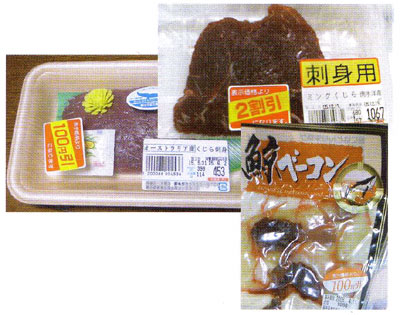Harpoons High, Consumption Low
The Whaling Series > Whale Consumption > Belly of the Whale
When it comes to harpooning the Captain is no Ahab. His experience can be summed up quite simply: an olive and a martini glass.
 But this week he takes to the sea. Join him as he once again takes a look at Japan's stance on whaling.
But this week he takes to the sea. Join him as he once again takes a look at Japan's stance on whaling.
The government may still be raising its whaling harpoons but Japanese are politely lowering their chopsticks.
That was the message on Tuesday of Junko Sakuma, a freelance journalist and representative of the Dolphin & Whale Action Network, at a press conference at the Foreign Correspondents' Club of Japan.
"The Japanese public does not have a high interest in eating whale meat," she said, citing data to indicate that stockpiles of whale meat in Japan has been steadily increasing over the past 20 years, reaching 5,000 tons in 2005.
Under the motto of cultural preservation, the Japanese government has continued "scientific whaling" - a controversial program that exploits a snag in the two-decade-old commercial whaling moratorium that allows for whales to be taken for research purposes. Later this week Japan will seek increased support at the International Whaling Commission (IWC) meeting to lift the ban altogether.
"With the small percentage of Japanese citizens actively campaigning for whale hunting," she said, "I am almost forced to believe the Japan Fisheries Agency is creating this fictional public opinion to promote the whale hunt."
Annual per capita consumption today amounts to 30 grams, or the equivalent of one serving of sashimi. This contrasts sharply with the 2.5 kilograms eaten in the early 1980s.
The current price of red whale meat (which could be sourced from, for example, fin or Sei whales) is approximately 580 yen per 100 grams with pricier whale bacon fetching 700 yen for a mere 40 grams. In the last 10 years the wholesale price has been sliced in half to 1,950 yen per kilogram.
"If the government," the environmentalist said, "is asking Japanese citizens to consume whale meat they have to explain to us how it is useful to us. The government's explanation thus far is insufficient."
This year's IWC conference is to open in the Caribbean nation of St. Kitts and Nevis on Friday. Guatemala, Cambodia, and the Marshall Islands are set to support Japan, likely giving the harpooners a majority within the 70-nation commission. (Overturning the moratorium will require a three-quarter majority but achieving a simple majority will allow for more control over the commission's direction.)
Each year, Japan's research whaling fleets pluck roughly 1,300 mammals from seas around the world. The studies, as conducted by Japan's Institute of Cetacean Research, is intended to determine that a "sustainable utilization" of certain whale species could be possible. Annual subsidies from the Japanese government to the program amount to 1 billion yen.
But why does the government continue to be actively interested in pursuing an industry in which demand for its product is in decline?
Sakuma could only offer that it might amount to cultural pride. The government, she said, is seeking support by tapping nationalist sensibilities: the international community views Japan's whale-eating, regardless of how prolific, as barbaric.
"The more you tell Japanese not to eat," she said, "Japanese fight. The more you tell Japanese to stop, they will fight back not to stop. This kind of push and pull is very sensitive."
Note: Image Courtesy of the Dolphin & Whale Action Network.
The Whaling Series > Whale Consumption > Belly of the Whale

